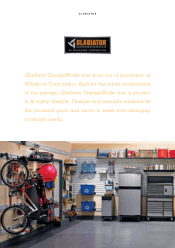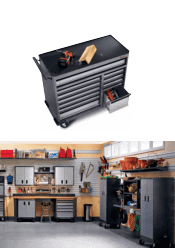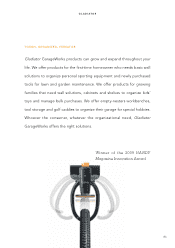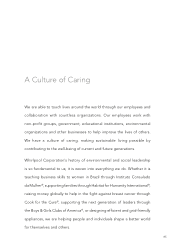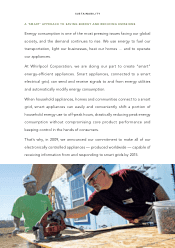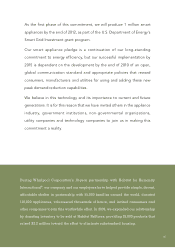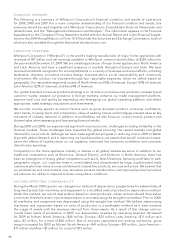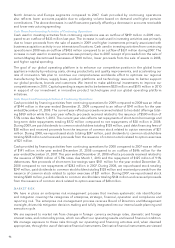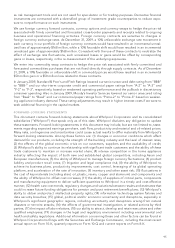Whirlpool 2009 Annual Report Download - page 92
Download and view the complete annual report
Please find page 92 of the 2009 Whirlpool annual report below. You can navigate through the pages in the report by either clicking on the pages listed below, or by using the keyword search tool below to find specific information within the annual report.FI N A N C I A L S U MM AR Y
The following is a summary of Whirlpool Corporation’s financial condition and results of operations
for 2009, 2008 and 2007. For a more complete understanding of our financial condition and results, this
summary should be read together with Whirlpool Corporation’s Consolidated Financial Statements and
related notes, and the “Management’s Discussion and Analysis.” This information appears in the Financial
Supplement to the Company’s Proxy Statement mailed with this Annual Report and in the Financial Supple-
ment to the 2009 Annual Report on Form 10-K filed with the Securities and Exchange Commission, both of
which are also available through the Internet at whirlpoolcorp.com.
E X EC U T I V E OV ER VI E W
Whirlpool Corporation (“Whirlpool”) is the world’s leading manufacturer of major home appliances with
revenues of $17 billion and net earnings available to Whirlpool common stockholders of $328 million for
the year ended December 31, 2009. We are a leading producer of major home appliances in North America
and Latin America and have a significant presence in markets throughout Europe and India. We have
received worldwide recognition for accomplishments in a variety of business and social efforts, including
leadership, diversity, innovative product design, business ethics, social responsibility and community
involvement. We conduct our business through four reportable segments, which we define based on
geography. Our reportable segments consist of North America (55% of revenue), Europe (19% of revenue),
Latin America (22% of revenue), and Asia (4% of revenue).
Our global branded consumer products strategy is to introduce innovative new products, increase brand
customer loyalty, expand our presence in foreign markets, enhance our trade management platform,
improve total cost and quality by expanding and leveraging our global operating platform and where
appropriate, make strategic acquisitions and investments.
We monitor country-specific economic factors such as gross domestic product, consumer confidence,
retail trends, housing starts and completions, sales of existing homes and mortgage interest rates as key
indicators of industry demand. In addition to profitability, we also focus on country, brand, product and
channel sales when assessing and forecasting financial results.
During 2008 and 2009, we experienced significant macroeconomic challenges including instability in the
financial markets. These challenges have impacted the global economy, the capital markets and global
demand for our products. Although we have made significant progress in reducing cost in 2009 to better
align with global demand, and in improving our liquidity position, we expect that we will continue to expe-
rience the effects of liquidity strain on our suppliers, continued low consumer confidence and consumer
discretionary spending.
Competition in the home appliance industry is intense in all global markets we serve. In addition to our
traditional competitors such as Electrolux, General Electric, and Kenmore in North America, there has
been an emergence of strong global competitors such as LG, Bosch Siemens, Samsung and Haier. In each
geographic region, our customer base is consolidated and characterized by large, sophisticated trade
customers who have many choices and demand competitive products, services and prices. We believe that
our productivity and cost controls, new innovative product introductions, and improved product price/mix
will enhance our ability to respond to these competitive conditions.
FAC T O R S A FFEC T IN G C O M PAR A BI L I T Y
During the March 2009 quarter, we changed our method of depreciation prospectively for substantially all
long-lived production machinery and equipment to a modified units of production depreciation method.
Under this method, we record depreciation based on units produced, unless units produced drop below
a minimum threshold at which point depreciation is recorded using the straight-line method. Prior to 2009,
all machinery and equipment was depreciated using the straight-line method. We believe depreciating
machinery and equipment based on units of production is a preferable method as it best matches
the usage of assets with the revenues derived from those assets. As a result of this change and our
overall lower levels of production in 2009, our depreciation expense by operating segment decreased
for 2009 as follows: North America—$46 million, Europe—$25 million, Latin America—$11 million and
Asia—$1 million, for a total of $83 million. Net of amounts capitalized into ending inventories, gross
margin increased for 2009 as follows: North America—$41 million, Europe—$19 million, Latin America—
$11 million and Asia—$1 million, for a total of $72 million.
88


